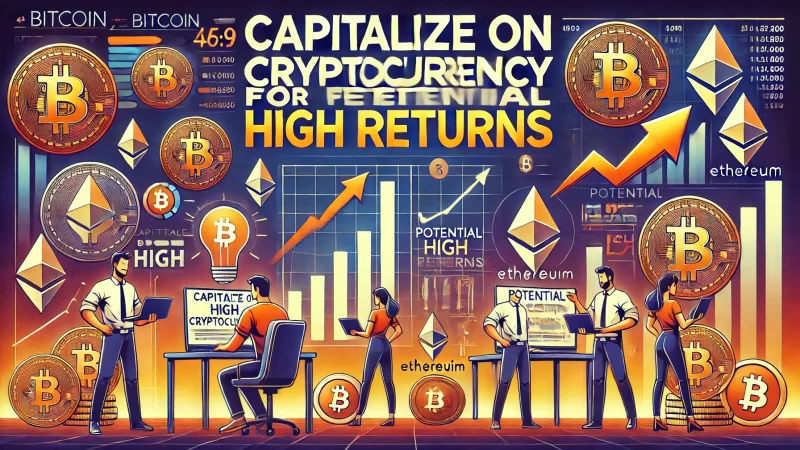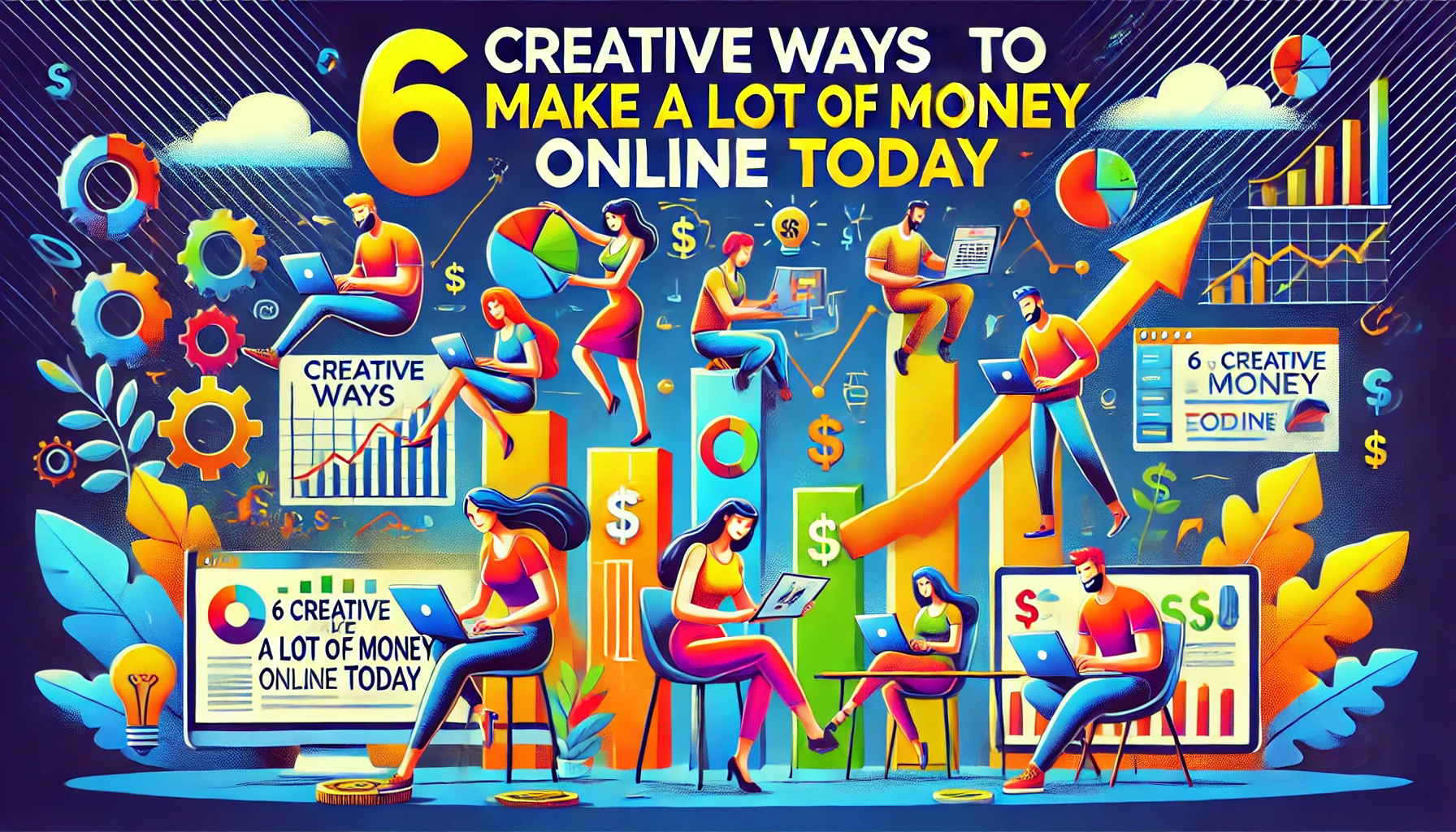Table of Contents
Are you wondering how to make a lot of money online today? Do you feel overwhelmed by the seemingly endless options and unsure where to begin? Whether you’re seeking passive income, a full-time business venture, or something in between, there are various ways to make a lot of money through online ventures.
This guide will walk you through seven proven methods to help you take control of your financial future, from affiliate marketing and email campaigns to freelancing and cryptocurrency. Read on to discover actionable strategies that can get you started immediately.
1. Affiliate marketing tips to maximize passive income streams

Are you searching for reliable ways to make a lot of money online? Affiliate marketing remains one of the most profitable methods if done right. By promoting products from other companies, you can earn a commission each time someone makes a purchase. However, maximizing these streams requires strategy and consistent effort.
For those new to affiliate marketing, it’s essential to understand how to choose the right programs and how to promote them effectively. Below, I’ll break down the critical steps and approaches you can take to succeed in this arena.
How to choose the best affiliate programs for high earnings
When selecting an affiliate program, always opt for high-commission products. I suggest choosing programs that offer recurring commissions, as this allows you to earn continuously from a single sale. This approach increases the long-term profitability of your efforts and builds a steady income stream.
It’s important to promote products you believe in. I’ve learned that promoting products aligned with your niche is more effective. It keeps your audience engaged, and they are more likely to trust your recommendations. This boosts your credibility and sales potential over time, ultimately leading to higher earnings.
Look at the demand for the product before jumping into a program. High-demand products will yield better conversion rates. I’ve found that evergreen products—those that solve ongoing problems—tend to perform better. These items offer a consistent market, giving you more opportunities to make commissions over time.
Ensure the program has reliable tracking and reporting tools. These tools allow you to measure the effectiveness of your marketing efforts. I always emphasize the importance of clear data because it helps you tweak strategies that lead to more earnings. A good affiliate program will provide you with all the data needed for growth.
Check out the company’s reputation before committing to a program. Some brands offer higher commissions but may not deliver quality products. I suggest reading reviews, testimonials, and ratings to ensure that the products you promote align with your values and are worth your audience’s trust.
Effective ways to promote affiliate products without spamming
One effective way to promote affiliate products is by creating valuable, problem-solving content. I recommend writing detailed blog posts or guides where you naturally include affiliate links. This adds value to the reader and feels less pushy, which increases the likelihood of conversions and avoids the stigma of spamming.
Social media platforms are great tools for promotion. I’ve seen great success using Instagram, YouTube, and Facebook to share helpful content that subtly directs followers to affiliate products. Engaging your audience with informative posts or videos can drive more interest, leading to higher affiliate commissions.
Email marketing is another powerful way to share affiliate products. Building a list of engaged subscribers gives you direct access to a warm audience. I suggest sending informative emails that include affiliate products naturally, rather than pushing hard sales pitches. This keeps your email campaigns authentic and effective.
Another option is to incorporate affiliate links in tutorials or product reviews. I find that when you explain how a product works and highlight its benefits, people are more inclined to make a purchase. This method also builds trust with your audience since you’re demonstrating the product’s value firsthand.
Lastly, optimize your website for affiliate marketing. Create dedicated sections for product recommendations, and ensure your affiliate links are placed in relevant content. This keeps your promotion efforts focused and organized, avoiding the clutter of excessive linking that can overwhelm your audience and decrease credibility.
Common mistakes to avoid in affiliate marketing for better results
One common mistake is promoting too many unrelated products. I advise sticking to one niche to build authority and trust. If you spread yourself too thin, your audience may question your recommendations. Keeping your focus ensures higher conversion rates and a more engaged following over time.
Neglecting your audience’s needs is another pitfall. I recommend always understanding the preferences and pain points of your target audience. You can tailor your promotions to address those specific needs, creating a personalized experience that drives better results and more conversions in the long run.
Another mistake I often see is failing to disclose affiliate relationships. I always advocate for transparency. Inform your audience that you’re earning a commission from the products you recommend. This builds trust and avoids any sense of deception, leading to more loyal followers and sustained success.
Some marketers rely on only one platform to promote their affiliate products. Diversifying your promotional channels—such as blogs, social media, and email marketing—is essential. By reaching your audience through multiple touchpoints, you increase your chances of capturing their interest and boosting sales.
Ignoring data and analytics is another trap. I recommend consistently monitoring the performance of your affiliate campaigns. Understanding what works and what doesn’t allows you to make necessary adjustments, ensuring your promotions are always optimized for better results and higher earnings.
2. Email marketing strategies that grow a loyal subscriber base

Are you wondering how to build a subscriber base that generates long-term revenue? I know email marketing is a proven way to make a lot of money online. It’s a direct channel to your audience, allowing you to nurture relationships and turn subscribers into loyal customers over time. Let’s explore key strategies to grow a solid email list.
To succeed with email marketing, it’s crucial to send valuable content regularly and create an engaging subscriber experience. Below, I’ll share the most effective email marketing tactics to grow your subscriber base and keep them engaged for the long haul.
Crafting compelling email sequences that convert into sales
Your email sequence begins with a strong welcome email. I recommend including a freebie or discount in the first email to capture attention and encourage engagement. This sets a positive tone for your future emails and makes subscribers more likely to stay on your list.
Next, focus on educational content. I’ve found that providing solutions to your audience’s pain points makes your emails valuable. People are more likely to purchase when they feel informed, so balance your promotional content with helpful insights that build trust and keep subscribers engaged.
Including customer testimonials or case studies in your email sequence adds credibility. I always emphasize the power of social proof—it helps validate the products you’re promoting. When subscribers see that others are benefiting from a product, they’re more likely to take action and make a purchase.
Segmenting your email list is another essential strategy. I suggest breaking down your subscribers into smaller groups based on their behavior or preferences. This allows you to send more personalized emails, which often leads to higher open rates, more clicks, and, ultimately, more sales.
Finally, always end with a clear call to action. Encourage your readers to take the next step, whether it’s clicking on a link, exploring a product, or redeeming an offer. Without a defined next action, even the most engaging emails can fall flat, so make sure your intent is clear.
Building an engaged email list without resorting to paid ads
Growing your list organically starts with providing valuable content. I recommend creating lead magnets like eBooks, templates, or exclusive content to encourage sign-ups. When people receive something valuable upfront, they’re more likely to stay subscribed and engage with your future emails.
Utilizing social media is an effective way to attract subscribers. Share snippets of your email content or lead magnets on your social platforms. I find that offering followers a sneak peek of the value you provide in your emails encourages them to sign up and stay engaged.
Your website can be a powerful tool for list building. I suggest placing opt-in forms on blog posts, landing pages, and pop-ups. Offering content upgrades, like checklists or exclusive tips, encourages readers to provide their email in exchange for additional value, further growing your list organically.
Consider collaborating with other creators in your niche. I’ve seen great results from joint ventures, where two brands exchange content or promote each other’s lead magnets. This cross-promotion exposes your email list offer to a new, highly-targeted audience without any ad spend.
Consistency is key when growing an email list. I advise sending regular, high-quality content to keep subscribers engaged. This keeps your audience looking forward to your emails and reduces the likelihood of unsubscribes. By maintaining value and relevancy, you’ll build a stronger connection with your subscribers.
3. Blogging techniques that generate consistent income long-term

Are you curious about blogging as a way to make a lot of money? Blogging offers a sustainable path to earning, but it requires the right strategies to turn it into a reliable income stream. From niche selection to content creation, the key lies in consistent effort and the right approach to monetization.
When you blog with a plan, it can become a powerful money-making tool. I’ve noticed that focusing on building an audience first and then using monetization strategies allows for long-term growth. Let’s explore the methods that can turn your blog into a source of consistent income.
How to pick a profitable niche and attract targeted traffic
Choosing a profitable niche is crucial to blogging success. I suggest selecting a niche that aligns with your interests while also having a sizable audience. A passion-driven blog ensures you stay motivated, while a large audience means more traffic, which translates into more earning opportunities through ads, sponsorships, and affiliate marketing.
It’s important to research the competition in your chosen niche. I find that niches with moderate competition are often the most profitable. Too much competition makes it harder to stand out, but a niche with little to no competition might not have enough audience demand. Strike a balance to maximize your blog’s potential.
To attract targeted traffic, optimize your blog for search engines. I’ve learned that using relevant keywords naturally in your posts will help your blog rank higher on Google. Traffic from search engines tends to be highly targeted, meaning readers are actively looking for the information you provide, making them more likely to convert.
Promote your blog on social media. Social platforms are great for driving immediate traffic. I suggest engaging with niche-related groups, sharing valuable content, and interacting with your audience. This helps build a community of loyal readers, increasing the likelihood of long-term traffic growth and monetization success.
Lastly, consider guest blogging on high-authority websites. This helps you gain backlinks, which boosts your blog’s domain authority and search rankings. Plus, guest blogging exposes your content to a larger audience, bringing new readers to your blog who are more likely to engage with your content and return for more.
Monetization methods for turning a blog into a money-making machine
Affiliate marketing is one of the most effective ways to monetize your blog. I recommend signing up for affiliate programs that are relevant to your niche. When you promote products that your readers are interested in, you create a win-win situation—you earn commissions, and your audience discovers valuable products.
Another popular method is to sell digital products. E-books, courses, or templates related to your blog’s content are great examples. I suggest creating products that solve a specific problem for your readers. Digital products often have higher profit margins because there are no shipping or production costs involved.
Display advertising is also an option, but I’ve noticed that it works best for blogs with high traffic. Programs like Google AdSense place ads on your site, and you earn money when visitors click on them. However, I believe it’s essential to avoid overcrowding your blog with ads, as this can deter readers from returning.
Sponsored content can be a lucrative income stream. Brands may pay you to create blog posts or reviews that feature their products. I suggest only accepting sponsorships from brands that align with your blog’s values. Authenticity is key, and promoting products you genuinely believe in will keep your audience’s trust intact.
Consider offering premium memberships or exclusive content. I’ve seen bloggers create membership programs where readers pay a monthly fee for access to unique articles, guides, or resources. This recurring income model can provide stability and reward loyal readers with high-quality content that goes beyond what’s available for free.
SEO and content strategies that boost blog revenue
Content is king, but SEO is the vehicle that drives traffic to it. I recommend starting with keyword research to identify what your target audience is searching for. Create content around these keywords, but ensure it’s valuable and engaging. The better your content, the more likely it is to rank highly in search engines and attract organic traffic.
Long-form content tends to perform better in search rankings. I suggest writing posts that go in-depth on a topic. Not only does this satisfy readers, but search engines like Google also prefer long, well-researched content. I’ve noticed that longer posts are more likely to earn backlinks and social shares, which boosts visibility.
Internal linking is another great strategy. By linking to other relevant posts within your blog, you help visitors stay on your site longer. This improves user experience and can increase ad revenue if you’re using display ads. Additionally, search engines see this as a sign of a well-organized site, helping improve your blog’s overall ranking.
I recommend updating your old blog posts regularly. Search engines favor fresh content, and updating your posts with the latest information can help maintain or improve their rankings. Plus, adding new internal links to older posts can give them a traffic boost, helping them generate more income over time.
Lastly, focus on building an email list. I believe that email subscribers are your most valuable asset because they are loyal readers. You can promote new blog posts, affiliate products, or digital goods directly to them, which often leads to higher conversion rates compared to other traffic sources.
4. Master the art of dropshipping with low startup costs

Interested in building a business with minimal upfront investment? Dropshipping could be the perfect solution. With dropshipping, you sell products online without having to hold inventory. This method allows you to focus on marketing and customer service while suppliers handle shipping, making it a low-risk option for aspiring entrepreneurs.
Dropshipping offers the potential to make a lot of money, but success depends on selecting the right niche and suppliers. I’ve found that finding a profitable niche and reliable partners is crucial for building a strong dropshipping business. Let’s dive into how you can master this business model.
Best dropshipping niches with high profit margins
Choosing a profitable niche is the first step to dropshipping success. I suggest focusing on trending products or evergreen niches like health, fitness, or tech gadgets. These niches often have high demand, allowing for larger profit margins. Conduct market research to ensure the niche has long-term potential before diving in.
Avoid overly saturated markets. I’ve noticed that choosing products with a lot of competition makes it harder to stand out. Instead, look for niches with moderate competition and high demand. This will give you a competitive edge and a better chance of turning a profit with each sale.
Another tip is to consider seasonal products. I find that selling items tied to holidays or events, like fitness gear for New Year’s resolutions or gifts for Christmas, can lead to higher sales volumes during peak seasons. However, balance this with evergreen products to ensure consistent sales throughout the year.
Focus on niches where people are willing to spend more. Luxury items or products that solve specific pain points tend to have higher price points and better profit margins. I recommend researching customer demographics in your niche to understand their spending habits and adjust your product offerings accordingly.
Finally, test the profitability of your niche before scaling. I suggest starting small and evaluating how well your chosen products sell. If you see consistent sales and good profit margins, then you can invest more in marketing and expand your product offerings to grow your dropshipping business.
Tips for finding reliable suppliers to ensure customer satisfaction
Finding reliable suppliers is essential for a successful dropshipping business. I recommend using platforms like AliExpress or Oberlo to source suppliers. These platforms have established networks of manufacturers, making it easier to find reputable suppliers. Always check product reviews and supplier ratings before choosing a partner.
Communication with your supplier is key. I’ve found that building a strong relationship with suppliers leads to better service. Make sure they can handle orders efficiently and communicate any potential delays. This ensures your customers receive their products on time, which helps maintain a positive reputation.
Test product quality before committing to a supplier. I suggest ordering samples to verify that the products meet your standards. Quality control is crucial, as selling subpar items can lead to customer complaints and returns. A good supplier will offer high-quality products and be responsive to your needs.
Negotiate terms with your supplier for better pricing and faster shipping. I recommend discussing bulk order discounts or quicker delivery options as your sales volume grows. This will improve your profit margins and enhance the customer experience, increasing the likelihood of repeat business and positive reviews.
Lastly, have backup suppliers. I advise always having a second option in case your primary supplier runs into stock issues or shipping delays. This ensures your business can continue operating smoothly without interruptions, which is critical for maintaining customer satisfaction and steady sales.
The marketing tactics that set successful dropshippers apart
Marketing is the backbone of any successful dropshipping business. I suggest focusing on targeted Facebook and Instagram ads to drive traffic to your store. These platforms allow you to narrow down your audience by demographics, interests, and behaviors, ensuring you’re reaching potential customers who are likely to buy.
Content marketing is another powerful tool. I’ve seen great results from creating blog posts, videos, or social media content that showcases your products. Tutorials or product reviews can build trust and establish your brand as an authority in your niche, which encourages customers to purchase.
Influencer marketing can be a game-changer. Partnering with influencers who align with your niche can expose your products to a larger audience. I recommend collaborating with influencers who have engaged followers, as this tends to lead to more conversions compared to those with large but less engaged audiences.
Offer promotions and discounts to attract first-time buyers. I believe that limited-time offers or special discounts can create a sense of urgency, encouraging visitors to make a purchase. Be sure to highlight these promotions prominently on your website and in your marketing campaigns to maximize their effectiveness.
Lastly, focus on building a brand. I suggest creating a unique brand identity that sets your store apart from competitors. From your website design to your customer service, every element should reflect your brand values. A strong brand not only attracts customers but also fosters loyalty, leading to repeat purchases.
5. Capitalize on cryptocurrency for potential high returns

Are you intrigued by the possibilities of cryptocurrency as a way to make a lot of money? I know many people have been drawn to its potential for high returns, but it requires a well-thought-out strategy. By understanding how to invest in crypto wisely, you can maximize your profit while minimizing risks.
To make the most of cryptocurrency, it’s essential to start with a solid foundation. Whether you’re new to investing or looking to expand your portfolio, these tips will help you navigate this often volatile market and turn it into a profitable venture.
Top cryptocurrency strategies for beginners to start profiting
If you’re new to cryptocurrency, I recommend starting with small investments. This reduces risk and allows you to learn without the fear of losing significant amounts of money. I also suggest researching different coins to understand which have long-term potential. Bitcoin and Ethereum are popular options with steady growth over time.
Diversifying your portfolio is crucial. I believe that investing in multiple cryptocurrencies spreads your risk and increases the likelihood of profit. Don’t put all your money into one coin. Instead, mix high-risk, high-reward coins with more stable options like Bitcoin to balance potential losses.
Another great strategy is dollar-cost averaging. I suggest buying a set amount of cryptocurrency at regular intervals, regardless of price fluctuations. This smooths out volatility and ensures that you don’t end up buying only when prices are high. Over time, this method helps you accumulate assets steadily.
Consider holding your crypto long-term. I’ve noticed that short-term traders often get caught in the market’s volatility, while long-term holders tend to see better overall returns. Patience is key when investing in cryptocurrencies, especially with coins that have the potential for future growth.
Lastly, stay informed about market trends and updates. I always emphasize the importance of following crypto news and developments. Changes in regulations, technological advancements, or market sentiment can have a significant impact on prices, so staying in the loop helps you make better investment decisions.
Risks involved with investing in cryptocurrency and how to mitigate them
Cryptocurrency is known for its volatility. Prices can fluctuate wildly within hours, and this can lead to significant losses if you’re not careful. I suggest setting stop-loss orders, which automatically sell your assets if they drop below a certain price, helping you limit potential losses during a market crash.
Security is another risk factor. I recommend using hardware wallets to store your cryptocurrency, as they are less vulnerable to hacking than online wallets. Make sure to enable two-factor authentication (2FA) on all your exchange accounts for an added layer of security, safeguarding your investments from unauthorized access.
Regulatory risks are also worth considering. I’ve noticed that some governments have taken steps to regulate or even ban cryptocurrencies, which can impact their value. Keeping track of legal developments in your country is essential. I advise diversifying into stablecoins or other assets to protect against potential regulatory crackdowns.
Emotional trading is a common pitfall. I believe that emotions often drive bad decisions, especially during market dips or surges. It’s easy to panic-sell when prices drop or get greedy during a rally, but I advise sticking to your strategy and not letting short-term fluctuations dictate your actions.
Liquidity can be an issue with smaller, less-established cryptocurrencies. I recommend checking the trading volume of any coin before investing. If liquidity is low, you may have trouble selling the asset at a fair price when you need to. Stick to coins with higher market liquidity to ensure smoother transactions.
Using cryptocurrency staking to generate passive income
Staking cryptocurrency is an excellent way to generate passive income. I’ve found that staking involves locking up your coins in a blockchain network to help validate transactions, and in return, you earn rewards. I suggest staking coins like Ethereum, Cardano, or Polkadot, which have well-established staking mechanisms.
The more coins you stake, the higher your rewards. I recommend calculating the expected annual return based on the coin you’re staking to determine if it’s worth locking up your funds. Some coins offer higher returns, but they may come with higher risks, so research thoroughly before making a decision.
Staking rewards vary based on the blockchain network’s protocols. I advise reviewing the staking requirements, including minimum coin holdings and lock-up periods. Some platforms allow flexible staking, where you can withdraw at any time, while others have fixed terms. Choose an option that aligns with your investment goals.
When staking, I suggest using reputable platforms like Binance or Kraken. These platforms offer secure environments for staking, reducing the risk of fraud or hacks. They also simplify the staking process, making it accessible to beginners who may not want to set up their own validators.
Be aware of the risks involved with staking. I find that one of the main risks is price volatility during the staking period. While your coins are locked up, their value could drop significantly. To mitigate this, stake coins you believe in for the long term, as their value is more likely to recover over time.
6. Creating and selling digital products for massive scalability

Have you ever thought about creating digital products to make a lot of money online? I believe digital products offer unlimited scalability since they can be sold repeatedly without additional production costs. Whether it’s an eBook, online course, or design template, you can reach a global audience with minimal upfront investment.
Digital products are ideal for those who want to create something once and profit from it indefinitely. I suggest starting with products that solve a specific problem for your target audience. Below, I’ll explore different ideas and strategies to get you started on your digital product journey.
Profitable digital product ideas that require low upfront costs
E-books are a popular choice for digital products. I recommend writing about a subject you’re knowledgeable in and that your audience is interested in. E-books are easy to create and distribute, requiring minimal investment beyond time. Platforms like Amazon Kindle Direct Publishing make it simple to publish and sell your work.
Online courses are another excellent option. I’ve noticed that creating a course around a specialized skill or knowledge can be highly profitable. Platforms like Udemy or Teachable allow you to host and sell courses with little to no upfront costs. Once the course is created, it can generate passive income for years to come.
Graphic design templates, such as website themes or social media graphics, can be lucrative. If you’re skilled in design, I suggest creating customizable templates that businesses or individuals can use. These products are quick to produce and can be sold on platforms like Etsy or Creative Market with minimal investment.
Audio files, such as sound effects, music, or podcasts, also make for profitable digital products. I recommend producing high-quality audio that caters to content creators, businesses, or hobbyists. Selling these files on platforms like AudioJungle or Pond5 allows you to reach a global audience without significant upfront costs.
Lastly, consider creating printables. I’ve seen sellers on platforms like Etsy offering printable planners, to-do lists, or art prints. These products require minimal upfront investment and can be created using free design tools. Printables are simple to distribute, and once they’re designed, you can sell them over and over.
How to market digital products to a global audience
The first step in marketing your digital products is building a strong online presence. I recommend using social media, blogging, or email marketing to attract potential customers. By consistently sharing valuable content, you can establish yourself as an authority in your niche, making it easier to sell your products globally.
Use targeted ads to reach a broader audience. Platforms like Facebook, Instagram, and Google Ads allow you to target users based on interests, location, and behavior. I’ve found that running ads with clear calls to action and offering discounts or free trials can drive traffic to your product pages and increase sales.
Affiliate marketing is another powerful tool. I suggest collaborating with influencers or bloggers who can promote your digital products to their audiences in exchange for a commission. This strategy expands your reach without requiring significant upfront costs and brings in customers from all over the world.
SEO is essential for attracting organic traffic. I recommend optimizing your product descriptions and website content with relevant keywords. This helps your digital products rank higher in search results, making it easier for potential buyers to find you. I’ve seen a significant boost in sales from well-optimized product pages.
Lastly, leverage email marketing to nurture leads and drive sales. I advise building an email list by offering a freebie, such as a sample of your digital product, in exchange for their email. You can then send targeted campaigns to this list, promoting special offers, new products, or updates that keep your audience engaged.
Best platforms to sell digital products and maximize profits
Selling digital products through platforms like Gumroad or Etsy is a great starting point. These platforms are user-friendly and handle the technical aspects of selling for you. I recommend Gumroad for selling directly to your audience and Etsy for reaching a broader market of digital product buyers.
For online courses, I suggest platforms like Udemy or Teachable. Udemy is a marketplace with a built-in audience, making it easier to get visibility for your courses. Teachable, on the other hand, allows you to build a more branded course platform, giving you full control over pricing and marketing.
If you’re selling design assets, Creative Market and Envato are excellent choices. I’ve seen designers earn consistent income from selling templates, graphics, and other digital assets on these platforms. They handle transactions and distribution, allowing you to focus on creating more products.
For musicians or audio creators, I recommend platforms like AudioJungle or Bandcamp. These platforms specialize in selling digital audio files and cater to specific audiences. Bandcamp, in particular, allows creators to sell their music directly to fans, giving you more control over pricing and marketing.
Lastly, consider hosting your digital products on your website using tools like Shopify or WooCommerce. I find that having your own store gives you the most control over pricing and customer relationships. While it requires more effort upfront, it allows you to keep more profits and build a dedicated audience.






